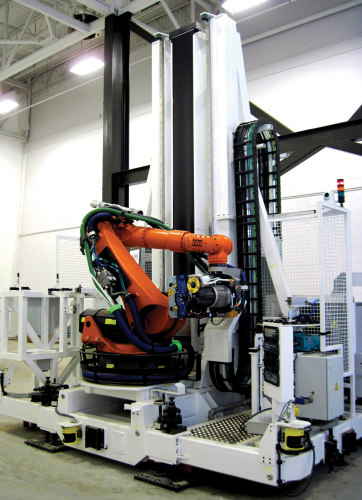
The CSeries features a body built of 70% advanced structural materials to deliver weight savings. 46% of the body – including the wings – will be advanced composite materials.
“The use of advanced robotic technology is emblematic of the clean-sheet approach we’ve taken to building the CSeries aircraft,” says Francois Minville, Vice President, CSeries Manufacturing, Bombardier Commercial Aircraft.
“The use of the robots will enable us to offer a superior aircraft at the best cost to our operators.”
Robot assembly
The company expects the use of robots to reduce the cycle time needed to assemble the aircraft by more than 40 hours.
Until now, Bombardier aircraft were assembled largely by hand. However, at a diameter of 12 ft (3.7 m), the fuselage of the CSeries family of aircraft is larger than any aircraft ever built by Bombardier. The wider fuselage offers superior comfort for passengers, but poses an ergonomic challenge during assembly.
Joining the CSeries fuselage sections by hand would require many hours to assemble the necessary scaffolding for workers to reach the top of the plane, as well as many more hours to move the scaffolding down the length of the fuselage.
The robots are able to extend to a full height of 18 feet, 9 inches (5.72 m). From their base, they can reach the top or the bottom of the aircraft.
In as little as 32 seconds, each robot can drill a small hole and then precisely rivet or hammer a fastener to the aluminium-lithium fuselage.
For the composite CSeries fuselage sections, the process takes 53 seconds to drill, add a sealant and then a fastener.
Four robots, working with one operator each, can join the fuselage sections for a CSeries aircraft in 17 hours.
Advanced vision control systems ensure that each hole is drilled within one-hundredth of an inch (0.254 mm).
Custom-made platforms will support and move the six robots, and end effectors, located at the end of the robotic arms, will house tooling to perform the work.
The 12 ton weight of the robots is necessary to ensure stability, and thus precision, during drilling and riveting. Most of the weight is located in the wheeled base platform, which allows the robots to travel the length of the fuselage during production.
A vertical lift raises or lowers the robot arm into place along the fuselage. The barrels of the end effector swivel into place when each task is performed, and two lasers, aimed at cross purposes, ensure that the fasteners are flush with the fuselage skin for optimal quality.
Training underway
Two of the robots have already been delivered to the Saint-Laurent Manufacturing Centre in Montréal, where Bombardier will assemble the carbon fibre composite aft fuselage and cockpit for the CSeries aircraft. These robots will fuse together the cockpit with a front section of the fuselage, and also assemble the aft fuselage.
Four more robots are scheduled to be installed at the Bombardier Mirabel facility, located about 30 miles (40 km) north of Montréal, where final assembly of the CSeries aircraft will take place. At Mirabel, the robots will rivet the front section, including the cockpit and the front fuselage, with the mid, rear and aft sections of the fuselage. Working in tandem, one on each side of the aircraft fuselage, the four robots will install the rivets to join the fuselage sections.
Robot operators and maintenance employees are being trained at the Saint-Laurent Manufacturing Centre to work on the robots. A fuselage test barrel, made by Shenyang Aircraft Corporation (SAC) of China, which will supply the CSeries aircraft centre fuselage, is being used to test manufacturing concepts.
The Bombardier CSeries aircraft, which are optimised for the single-aisle, 100- to 149-seat market, are scheduled to enter into service in 2013.






